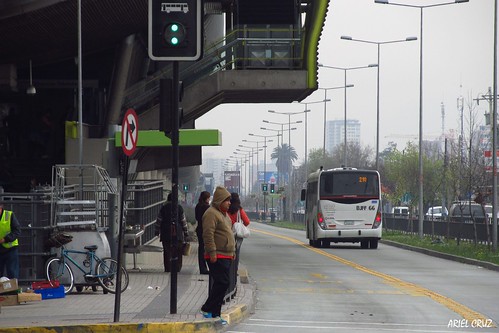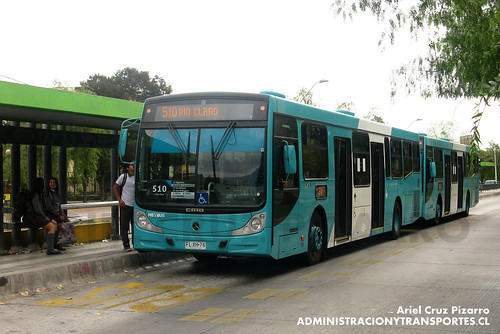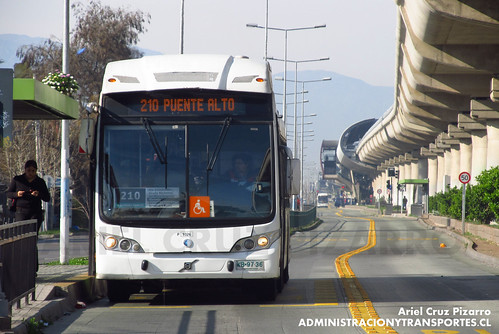Hi! I will continue writing in this blog because now I'm preparing myself for TOEFL test, so I need to improve my Writing level. In fact, Reading and Listening section are no problem for me, I'm touching the level required. I'll write this essay thinking that maybe someone want to know more about Transantiago and Santiago, my dear city. I hope this goes well. My goal is to write an essay of 1.100 words each day.
TRANSANTIAGO
Transantiago is the public transport system of Santiago since 2007. The system was conceived as a Bus Rapid Transit system, it means that Santiago would have exclusives bus lanes that improve commercial speed of the buses and do neater the public transport in our city. Santiago's subway would be the system backbone and the buses would do two types of routes: main services ("troncal") that across all the city and local services ("alimentadores") that connect houses and residential sectors with main services and subway.
In theory, Transantiago would be a Revolution! We had old yellow microbuses that had a lots of problems, these buses had administrated almost all by microentrepeneurs, each avenue is full of buses which aren't being occupied efficiently. The competence was so rude, bus drivers fought with other bus drivers in the street, there was "race buses" because if you're not fast, you could lost passengers. No, it was a insanity! Bus drivers had not pension savings or social security, they only won money with commissions of passenger transported (a fraction of a ticket).
When Transantiago was totally implemented in 2007, the people missed some of the characteristics of these yellow buses. Maybe this system was unsafe and the buses were not in the best conditions, but it had direct routes so you could take one bus and get home and the seats are more comfortable. The first days of Transantiago were chaotic, people don't have the complete information about the bus routes and they don't understand the maps, the buses were filled and subway too. They promised various technologies as fleet management, security system inside the buses, better travel experience but the only one technology that was working in these days was pay with magnetic card (Bip card).
Between 2007 and 2009, Transantiago was a serious political issue. The system should be a self-sustaining transport but it hadn't work. Transantiago's operation has generated losses since its beginning, so the state had always to pay unfortunately for the political opposition. Bachelet had a high disapproval on surveys (45%). There were changes in the ministries and they tried to improve the system. I know that theorically the best public transport systems are subsidiated, but Chile is an extreme case of subsidiary State. Our subway is self-sustaining too!
Basically, Transantiago born bad because there was a wrong calculating fleet. When experts did these calculations they were thinking in a system with exclusives bus lanes built, but in fact Government promised around 300km (around 186 miles) and just now we have around 50km. They thought replace yellow microbuses (around 7.000) with 4.600 new Transantiago buses because the high commercial speed and the articulated buses would have greater capacity and it would not need to have as many buses. One of the short-term solution was to incorporate 1.000 old buses to do Transantiago routes. Now, the system has around 6.500 buses.
Since 2008, bus companies stop buying articulated buses because these buses has high operational costs, there was a high rate of evasion of payment (another great problem of Transantiago) and the routes aren't designed for these buses. In the next years, it's probably that articulated buses left the city due these machines are ending its useful life. Now, bus companies buy a new standard with doors on both sides. Politicians promised to have a great bus lane on Alameda with these characteristics.
I say evasion of payment its a great problem and you should believe me, it is. In March 2014, the rate was 31%. To resolve this situation, the law is more tougher and implicates an high fine. In addition, bus companies had to hire guards that works at bus stops and they watch everyone pays. Other bus companies implement turnstiles inside their buses and there are two companies that has an commercial relation with a legal persecution company.
There are people that don't pay because their convictions (they think the system is really bad), another people don't have charged the card (it's like a prepaid card) but they need to transport, at peak hours it's common that buses were filled and you only can get on the bus through the back door. Finally, there are a group of people that can't pay because they have very low salaries. The bus fare is expensive ($640 CLP, $1,1 USD) if we comparate it with the minimum salary ($210.000 CLP - 352,5 USD), people with minimum salary would spends around 12% only in Transantiago.
When you pay the bus or the subway, you can do some combinations within a time period (90 minutes). You can take maximum three buses with different routes or two buses and the subway. In the first days of the system, you can do the same for 2 hours. The problem is that sometimes the bus delay pass or don't stop, our city is relatively big (across north-south or west-east take around 3 hours in buses) and the majority of movements are between residential sectors (periferia) and the downtown or another working poles that are near the center of the city, so you always takes about 1 hour or a little bit more. If one of the buses delay, maybe you could exceed 90 minutes and you must pay another bus to get work. The only people that have a minor fare are students with a respective card ("Pase Escolar" - Scholar Pass), we pay around 35% of adult fare.
The habitual schema of use in the morning is that people walk to bus stop, they wait a local bus (with minor frecuency than main services), take it and then they get off at subway station or a point where they can take another main service. If you're tourist, it's probably that you always attain to combinate because the subway is a fast transport and the turistic atractives are near to downtown or your accomodation place.
Transantiago was made to upgrade our public transport and decrease the use of car, but in the last year the Public Transports's demand suffered a low. The great economic moment of the country and different trade agreements (like China) favored people to buy new cars, in Santiago it's common to see new citycars or Chinese cars that are more cheap than other brands. This situation decrease our quality of life because we have slow-moving and pollution.
Finally, I could say that Transantiago is better than yellow buses in different aspects (security, pay with magnetic card, better technology inside the buses, better international image, the possibility to combinate without cost with other bus or subway) but there are some problems that we need to fix yet.
Our city depends of subway operation and they work to limit, if subway can't operate (due to suicides, technical problems, whatever) our city collapses (see photo above)! We need to improve our routes to really satisfy people needs, due many routes was made for bidding rules, it would avoid competence (one of the most complicated problems of yellow buses) but generates unattractive routes.
Bonus Track
Do you want to know how it's a travel in one of our articulated buses? I made a video to answer this possible question. Pay attention because I chose a route that pass across Providencia and Santiago downtown, so you can know some points of my city :)






No hay comentarios:
Publicar un comentario